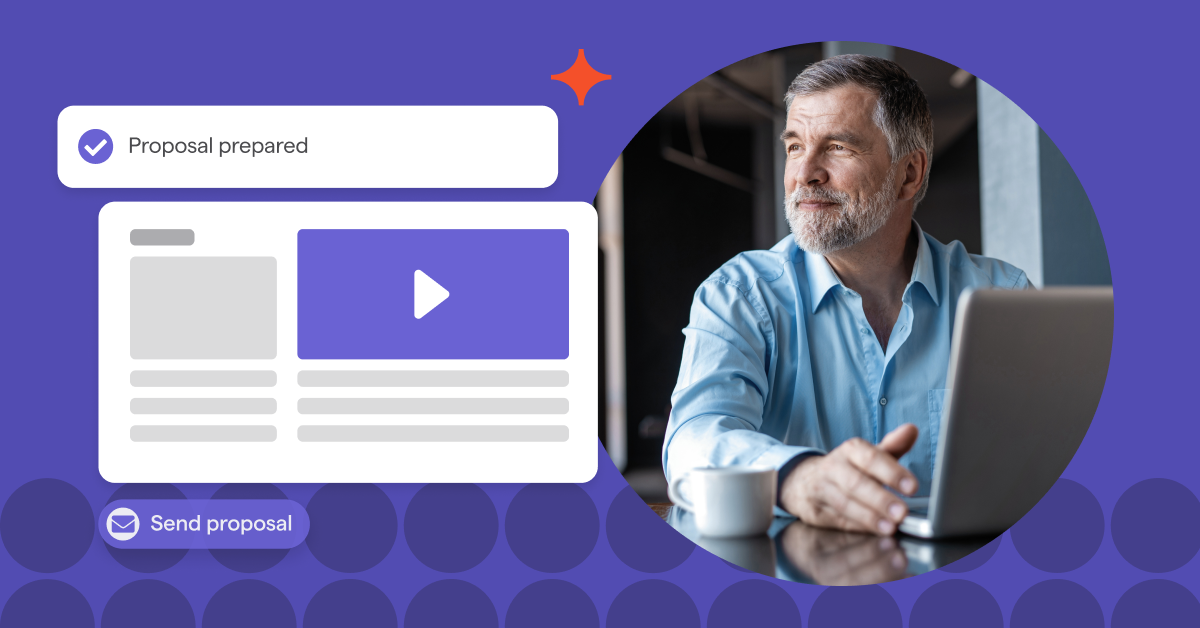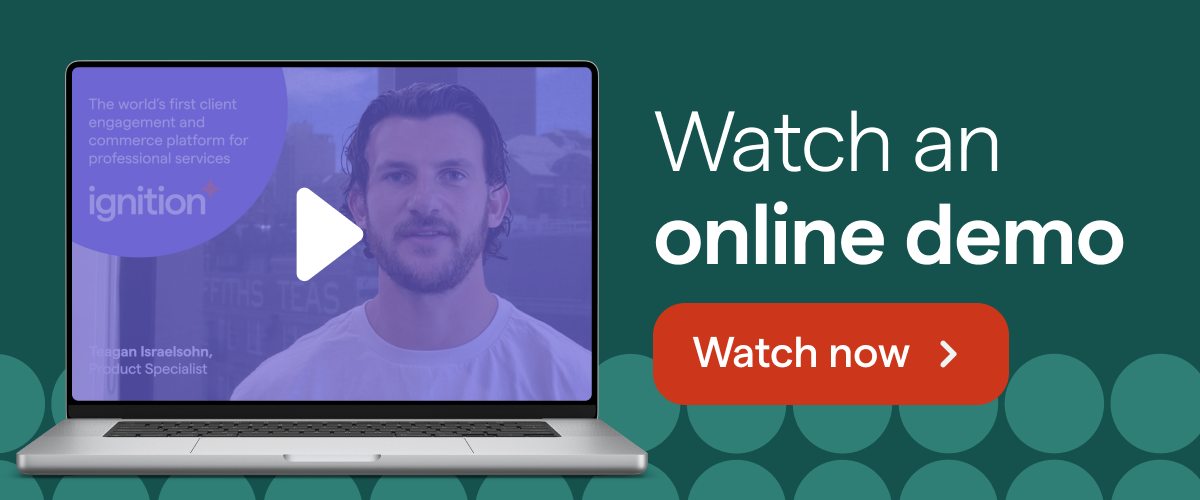How to write a business proposal that wins you more clients (with tips and examples)

A business proposal is one of the most important documents you'll create in your firm. Done right, it enables you to showcase your services, impress potential clients, and win more business. But when your business proposal template isn't crafted correctly, it can fail to make an impression and send potential clients elsewhere, possibly never to return.
Needless to say, being thoughtful, thorough, and creative with your business proposals is a must. If you need help doing that, this article has you covered. We'll discuss the following:
- 7 Steps for writing a winning business proposal
- Step 1. Gather information about your client.
- Step 2. Prepare your business proposal outline.
- Step 3. Craft your welcome message or introduction.
- Step 4. Write a compelling summary.
- Step 5. Explain your pricing.
- Step 6. Ask for payment details.
- Step 7. Review your client agreement or letter of engagement.
FAQs about business proposals – including 5 key tips for success
Get set to automate manual processes and free up admin time.
What is a business proposal?
A business proposal (sometimes referred to as a client proposal) is a document that a company sends to prospective clients to win their business. As part of the sales process for professional service providers – such as marketing consultants, advertising agencies, digital marketing agencies, and accounting and tax professionals – a business or client proposal communicates what you can do for the client and the value you provide.
7 steps for writing a winning business proposal
Having defined what a business proposal is, let's discuss how to produce one in seven steps.
Step 1. Gather information about your client
The first step to creating a winning proposal starts before you start writing it. Ensure you have all the information you need to craft a thorough, well thought-out document.
This involves researching your potential clients' market and asking them for any information you might need to craft their proposal, such as details about their internal processes. For instance, if you're writing a digital marketing proposal, it would make sense to learn about their current channels, how much they're spending, and so on.
If you're a social media marketing agency, you'll want to learn about their top social platforms, follower counts, influencer partnerships, etc.
Whatever the case, make sure the key details are prepared before you start writing to ensure a smooth process when you're producing the proper content.

Step 2. Prepare your business proposal outline
Already have all the information you need? Great. The next step is to write your business proposal outline. At this stage, you'll want to lay out the key sections of the document. If you're using a business proposal template, it should provide the following essential elements:
The specific information you'll include in each section will depend on the prospective client, but the list above should give you a clear idea of what your business proposal should contain.
Once you have all of the information you need, it's time to start populating the sections of your business proposal.
Step 3. Craft your welcome message or introduction
This section is the first thing your new client sees. Your message or introduction provides an opportunity to recap discussions you’ve already had with them and explain what needs to happen from here. Here’s an example:
Hi Pauline,
Thanks for taking the time to chat earlier today. Your business is at the perfect point to get a beautiful website designed.
As promised, here is our proposal. Check out our brochure on the left for more information.
When you're ready to start, just enter your payment details and sign this proposal.
Should you have any questions, you can reach us at {{ email address }} or using the chat function below.
We are excited by the prospect of working with you to expand your company’s image on the web. We hope we can begin collaborating soon!
Regards,
Tom
Step 4. Write a compelling summary
How to get started: While the welcome message presents your proposal and outlines next steps, the opening paragraphs of your summary can be used to provide an overview of the entire proposal. It highlights the client's key points, goals, and the value you’ll provide. This opening paragraph is useful for decision-makers who may not have time to read the entire document. Use it to cover the proposal's main points and to capture the reader's attention.
Problem statements: Include problem statements to clearly articulate the issues or challenges your prospective client is facing. These statements also justify the need for your services.
Proposed solutions: Your proposed solutions should be well-aligned with the problem statements and demonstrate the effectiveness, feasibility, and potential benefits that your solutions will bring. Here’s an example:Despite investing in high-quality content and providing an excellent user experience, your website is facing declining organic growth due to updates to the search engine algorithm. This has led to reduced visibility in search engine results, negatively impacting organic traffic, lead generation, and conversions.
We propose a holistic SEO management strategy that integrates targeted keyword usage, website and content optimization, link building, and local SEO enhancements to increase your website visibility, bolster organic traffic, and boost conversion rates.
Outline your scope of work and services: This is where you detail how you'll carry out your proposed solution. Below your opening paragraphs, create the scope-of-work section, describing the services you'll provide to the client in detail.
For example, if you're a full-service digital marketing agency, this part may include services such as:
An audit and analysis.
Website optimization.
Content marketing.
Social media management.
Paid advertising.
Email marketing.
Digital marketing reporting.
On the other hand, accountants can use this section to list services such as:
Bookkeeping.
Payroll.
Tax planning.
Tax filing.
Setting expectations: Your scope of work should also outline the responsibilities of both parties. This could mean that you include specifics such as these:
You (the service provider) are expected to complete the project in 15 days.
The client is expected to send their documents in a timely manner.
Ironing out these expectations will help you manage out-of-scope work (also known as ‘scope creep’) effectively, and ensure a smoother client engagement. Having clear expectations also prevents disputes from escalating.
According to Joshua Lance, Head of Accounting (AMER) at Ignition, "If there's ever a disagreement down the line, we can always go back to that proposal and say, 'Okay, well, what do we agree upon? What's in there?'. Having the right scope and expectations sets the stage for mutual agreement between the parties," he says.

💡Here's a pro tip when mapping out your scope: Be detailed about what each service entails and what it does not include. As you can see from this spreadsheet of sample services for an accounting firm – which is similar to an agency rate card – that you should aim to be fairly granular about this to ensure every aspect of what you do is itemized and described.
This helps to ensure you and your team are clear about services considered in-scope and those that are out of scope. It also means you can be crystal clear on your proposal about the services you’ll be providing.
"A good proposal needs to have a really detailed scope of what the work is going to be," says Joshua Lance. "We have to be very specific about what's in the scope and what's out of the scope, so it's clear what clients are actually buying, and we're all on the same page."
'We have to be very specific about what's in the scope and what's out of the scope, so it's clear what clients are actually buying, and we're all on the same page.'
Joshua Lance, Head of Accounting (AMER) at Ignition
He adds that being general or unclear with the scope can lead to inaccurate assumptions or mismatched expectations. For example, you and the client may define the term ‘accounting services’ differently. In your firm, ‘accounting services’ may mean simply doing bookkeeping, but your client may expect the service to include tax preparation.
Similarly, in digital marketing. The term ‘reporting’ is broad. Are you simply providing numbers around traffic and conversions? Will reports include data from all channels? Be sure to specify the information you provide to ensure prospective clients know exactly what's included in your services.
Aside from keeping you, your team and your client on the same page, being clear with your service scope and description helps to better communicate your value, says Michelle Timperley, Senior Key Account Manager (APAC) at Ignition.
"If you enhance your description and tell your clients what you are doing, it adds more value to the service that you're delivering," she says.
Here's a great example below, from Ignition's business proposal template library, of how clearly worded scope of services can look in a proposal for an accounting and tax firm. Instead of just saying, ‘Prepare a tax return’, the document has a bullet list of all the steps and deliverables included in the service.


Follow the same format in your proposals to clearly communicate your offerings.
Step 5. Explain your pricing
No business proposal is complete without a section on pricing. This part should detail your fees and the schedule for when clients will be billed.
Similar to the ‘Scope of work and services’ section, the pricing part of the proposal needs to be crystal clear to avoid misunderstandings.
As Joshua Lance explains, "You need to be clear on pricing. If you're doing fixed fees, say what that fixed fee is. If you're doing hourly rates, put the hourly rate and give an expectation of how many hours you think it's going to be, so that person who's buying it knows what they're getting, and there are no surprises later on."
He continues, "I've seen too many accounting firms just say, 'Oh, it's between $150 and $300 an hour,' but they don't give any parameters around that. And then your client sees massive bills, and they'll think, 'Okay, I didn't expect it to be that much'."
These issues can be prevented by crafting a pricing section that's straightforward and unambiguous. Aim to put a fixed dollar amount or at least a close estimate whenever possible.
Pro tip: If you are charging fixed fees, be sure to include an ‘out of scope’ component to your engagement, says Michelle Timperley. Doing so gives you the ability to easily charge for additional work.
When you receive an out-of-scope request from a client, with Ignition’s Service Edits feature, you can adjust the price, quantity or billing details of your services – even after these have been accepted by your client. When you make any of these changes, the platform notifies your client of adjustments to the agreement without the hassle of signing a whole new proposal.
Step 6. Ask for payment details

Related article: The ultimate guide to automated invoicing
Step 7. A client agreement or letter of engagement
In Ignition, your proposal forms part of your client agreement or letter of engagement to save you time. Once a client signs and accepts your proposal, Ignition automatically converts it to a client agreement or engagement letter, so you’re always covered. The software keeps a history of legally binding e-signatures for your records.
If you’re an accounting and tax professional, you can get a head start using Ignition’s legally vetted, industry standard terms, and you can also upload your own terms. You can even access engagement letter templates from selected accounting industry bodies. This ensures there’s less errors, and less admin, while keeping you compliant.
Related article: The ultimate guide to contract automation
Frequently asked questions about business proposals
Now, you have your seven-step process in place for creating an effective proposal, you may have questions about how to get started quickly, so you start winning business.
Q. How can I create and send proposals and engagement letters in minutes?
By using a business proposal template. If the thought of producing a proposal feels daunting, don't worry. Ignition has a library of business proposal templates for various industries, covering the United States, Australia, the United Kingdom, Canada, New Zealand, and South Africa.
Professional services providers have vetted each business proposal template so they're all optimized for success. These are just few of the business proposal templates on offer below:
Professional services proposal templates
Consulting proposal template.
Mobile app development proposal template.
Marketing proposal template.
Website design proposal template.
Software development proposal template.
Video production proposal template.
IT project proposal template.
Public relations proposal template.
Logo design proposal template.
Technology proposal template.
SEO proposal template.
PPC proposal template.
Social media proposal template.
Digital marketing proposal template.
Graphic design proposal template.
SaaS proposal template.
Business coaching proposal template.
US accounting proposal templates
Future Firm 3-tiered options.
Tax planning & advisory (individual).
Tax planning & advisory (business).
S-corp tax return with 3 options.
Recessionary service package.
QuickBooks services – 3 options.
Partnership tax return.
Bookkeeping services with 3 options.
Individual tax return with 3 options.
People advisory services with 3 options.
C-corp tax return with 3 options.
1099 preparation and filing.
NATP Engagement Letter Template (National Association of Tax Professionals).
US bookkeeping proposal templates
Future Firm 3-tiered options.
QuickBooks services – 3 options.
Bookkeeping services with 3 options.
NATP Engagement Letter Template (National Association of Tax Professionals).
The perfect proposal template will depend on your specific needs, so explore the templates above and find one you can adapt for your business.
Q. Can I send proposals in bulk?
Yes, in Ignition if you have multiple proposals that you need to create and send, you can take advantage of the bulk proposal creation and send process.

Q. Are there different types of business proposals?
Yes, business proposals come in many forms. And while most follow the same format and have similar sections, there are different types of business proposals you can use. The right type depends on the purpose or needs to be addressed.
Let's take a look.
- Formal solicited business proposal: This type of proposal is in response to a formal request for proposals (RFP) or invitation to bid (ITB) from a client or organization. It follows a structured format and typically includes detailed information about the project requirements, scope of work, deliverables, timeline, and pricing.
The flow of your proposal will depend on what the prospective client outlined in their request or invitation.
- Informal, unsolicited proposal: Unsolicited proposals are submitted to a potential client or organization without a prior request. It presents a business idea, product, or service that could address a need or opportunity. This type of proposal may have a relatively lower chance of being accepted, mainly because the client didn't request it.xtagstartz
Q. How many pages should my business proposal include?
There are no hard and fast rules regarding the number of pages a business proposal should have.
While it's not uncommon for a business proposal to have 10-20 pages, the length of your proposal will depend on the complexity of the client's challenges and the amount of work you'll be providing.
Some projects are straightforward, while others are more complicated, in that they have multiple milestones and dependencies.
Whatever the length of your proposal, make sure to strike a balance between providing sufficient information to convey your ideas and value proposition while keeping the proposal concise and focused.
Q. What if I want to give clients the option to choose from a range of proposals? Can I do that?
Yes, in Ignition you can take your sales process to the next level by allowing clients to choose from up to three proposal options. Packaging your services in this way makes it easy for you to guide clients to select the recommended option that best suits their needs.

Q. How can I make sure a client accepts my business proposal?
Below are best practice tips to follow that can maximize your chances of having your proposal accepted by a prospective client:
Tip 1. Make sure your business proposal looks professional and on-brand
One key tip for creating a proposal that stands out is ensuring that it looks polished and accurately reflects your brand.
"This is your way of setting yourself apart from other firms that the client may be talking to," Joshua Lance explains.
He adds, "It can't just look like a Word document, because that doesn't represent you at all. It doesn't show who you are. So, if you're a fun and tech-forward type of firm, your proposal and the things in it should reflect that."
With Ignition, you can include a digital brochure about your business inside your proposal. In addition to keeping your proposal on-brand, it creates a more seamless client experience. If your client sees that your proposal is consistent with your website, voice, and personality, they'll have a better brand perception overall.
Tip 2. Regularly update your business proposal
Michelle Timperley emphasizes the importance of keeping your proposal and accompanying brochure up to date. This includes using recent client testimonials and keeping your team page current.
It's also essential to regularly update your proposal's terms and conditions to reflect the current laws and regulations in your market.

Tip 3. Use video in your client proposal
Another great way to stand out is to incorporate videos into your proposal. This will make it more dynamic and personal, ultimately increasing the likelihood of clients saying ‘yes’ to your proposal.
"Videos are amazing and underutilized in so many ways," says Michelle Timperley. "When I started using videos [in] mine, my acceptance rate went from two days down to two hours."
Joshua Lance agrees: "Video comes across as more personal because they're seeing you talking to them and explaining things," he says. "It makes it feel more human," particularly compared to traditional text-only client proposals.
As for what content to include, Michelle Timperley says you can use video to explain the proposal, outline the terms and conditions, and give instructions on how to accept it.
Ignition makes it simple to add videos to your proposal. The software supports YouTube, Vimeo, and Loom, and there's no limit to the size and length of your videos.
Tip 4. Follow-up with your potential client
Following up may feel like an awkward task, but it's critical in the business proposal process. Research has shown that users who follow up on their messages get an average reply rate of 13% compared to nine percent for those who don't follow up.
If you're uncomfortable following up with prospects, you can make this step easier with the right business proposal software.
Ignition, for example, enables you to send automated proposal reminders. Simply indicate how many days to wait before following up, and the software will send reminder messages automatically. You can also specify how many reminders to send.

Subject: Got any questions about the proposal?
Hi NAME,
Last week I sent through the proposal doc you asked for as part of your website redesign project. I hadn’t heard back from you since and so I wanted to check in and ask if you have any questions?
In any case, I’d love to organize a quick call to talk it over in more detail. Would Tuesday at 3pm work for you? I’m really excited about the project and am keen to get it started as soon as possible!
Sincerely,
YOUR NAME
Tip 5. Remove friction from the ‘acceptance’ process to get paid faster
So, you've sent a killer business proposal, and the client is eager to move forward. What's next?
The next logical step is for the client to inform you that they're ready to move forward. They'll sign an agreement, and the service provider collects the initial payment.
Traditionally, this process takes some time because it requires clients to email you back, sign documents, and send over their payment information. This results in an unnecessary back and forth between both parties.
Fortunately, in Ignition you can streamline the acceptance process by allowing clients to sign and provide their payment details from within the proposal. They can enter their payment details through an online portal without having to navigate away from the business proposals. There’s more information about payments in Step 6.
The main reason to collect payment details upfront in your proposal is so you can get paid faster! In Ignition, when the invoice is due it automatically takes the payment. This puts an end to late payments and protects your cash flow.
Related article: Use automation to reduce accounts receivable to improve cash flow
Automate manual processes to free up admin time
Your business proposal can make or break a potential client relationship, which is why it's critical that you put a lot of thought and effort into every proposal you send.
Need help doing just that? With Ignition, you can create and send proposals and engagement letters in minutes with custom templates you can use time and time again.
You can also automate billing and payment collection based on your billing and fee schedule, and ‘set and forget’ once a client signs your proposal. You’ll save hours of admin when you connect Ignition to your favorite business apps to automate workflows from the moment your client signs your proposal.
Invoice creation and reconciliation happens automatically when Ignition is connected with QuickBooks Online or Xero, so everything happens seamlessly behind the scenes. Want to find out more? Watch an online demo.


